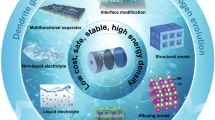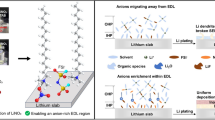Abstract
The electrolyte, one of the key components for the energy storage in the vanadium redox flow battery (VRFB), hinders the further commercial applications of the VRFB due to the poor thermal stability of the positive electrolyte at the elevated temperature and the inferior activity on the interface of electrode. To enhance the performance of the positive electrolyte, a zwitterion-type molecule pyridinium propyl sulphobetaine (PPS) with negatively charged sulfonic group and positively charged pyridine group is adopted as the additive for the positive electrolyte. In this study, we have proved that PPS can be adsorbed on the electrode through sulfonic group and pyridine group under both positive potential and negative potential, which can effectively modify the interface of electrode. Compared to other additives containing –NH2/–SO3H groups, PPS containing pyridine group may effectively eliminate the side effects of protonation (–NH3+) and intermolecular hydrogen bonding (-SO3−---+H3N-) in acidic electrolyte. Moreover, the PPS-containing V(V) electrolyte presents a better stability at 50 °C compared to the blank V(V) electrolyte. As a consequence, with the addition of 1% PPS in positive electrolyte, the VRFB exhibits higher efficiencies (80.78% VE and 78.17% EE compared to 78.95% VE and 76.87% EE of the blank VRFB at 100 mA cm−2) and 76.28% capacity retention after 100 cycles which is 5.22% higher than that of the pristine VRFB. Herein, the study of zwitterion molecules provides a meaningful reference for the further research on organic additives for VRFB.









Similar content being viewed by others
References
Yu L, Lin F, Xiao W, Xu L, Xi J (2019) Achieving efficient and inexpensive vanadium flow battery by combining CexZr1−xO2 electrocatalyst and hydrocarbon membrane. Chem Eng J 356:622–631
He Z, Li M, Li Y, Zhu J, Jiang Y, Meng W, Zhou H, Wang L, Dai L (2018) Flexible electrospun carbon nanofiber embedded with TiO2 as excellent negative electrode for vanadium redox flow battery. Electrochim Acta 281:601–610
Li L, Kim S, Wang W, Vijayakumar M, Nie Z, Chen B, Zhang J, Xia G, Hu J, Graff G, Liu J, Yang Z (2011) A stable vanadium redox-flow battery with high energy density for large-scale energy storage. Adv Energy Mater 1:394–400
He Z, Jiang Y, Li Y, Zhu J, Zhou H, Meng W, Wang L, Dai L (2018) Carbon layer-exfoliated, wettability-enhanced, SO3H-functionalized carbon paper: a superior positive electrode for vanadium redox flow battery. Carbon 127:297–304
He Z, Jiang Y, Wei Y, Zhao C, Jiang F, Li L, Zhou H, Meng W, Wang L, Dai L (2018) N,P co-doped carbon microsphere as superior electrocatalyst for VO2+/VO2+ redox reaction. Electrochim Acta 259:122–130
Ye R, Henkensmeier D, Yoon SJ, Huang Z, Kim DK, Chang Z, Kim S, Chen R (2017) Redox flow batteries for energy storage: a technology review. J Electrochem Energy 15:010801
Wang N, Chen Y, Han H, Cao M, Bi X, Peng S, Chen X (2017) Influence of L-cystine as an additive in the negative electrolyte on performance of vanadium redox flow battery. Int J Electrochem Sci 12:2893–2908
Hwang J, B-m K, Moon J, Mehmood A, Ha HY (2018) A highly efficient and stable organic additive for the positive electrolyte in vanadium redox flow batteries: taurine biomolecules containing –NH2 and –SO3H functional groups. J Mater Chem A 6:4695–4705
Wu X, Liu S, Wang N, Peng S, He Z (2012) Influence of organic additives on electrochemical properties of the positive electrolyte for all-vanadium redox flow battery. Electrochim Acta 78:475–482
Pasala V, Ramanujam K (2017) On in-situ redox balancing of vanadium redox flow battery using D-fructose as negative electrolyte additive. ChemistrySelect 2:720–727
Liu J, Liu S, He Z, Han H, Chen Y (2014) Effects of organic additives with oxygen- and nitrogen-containing functional groups on the negative electrolyte of vanadium redox flow battery. Electrochim Acta 130:314–321
Jia Z, Wang B, Song S, Chen X (2012) Effect of Polyhydroxy-alcohol on the electrochemical behavior of the positive electrolyte for vanadium redox flow batteries. J Electrochem Soc 159:A843–A847
Wang G, Chen J, Wang X, Tian J, Kang H, Zhu X, Zhang Y, Liu X, Wang R (2013) Influence of several additives on stability and electrochemical behavior of V(V) electrolyte for vanadium redox flow battery. J Electroanal Chem 709:31–38
Xiao S, Yu L, Wu L, Liu L, Qiu X, Xi J (2016) Broad temperature adaptability of vanadium redox flow battery-part 1: electrolyte research. Electrochim Acta 187:525–534
Wang K, Zhang Y, Liu L, Xi J, Wu Z, Qiu X (2018) Broad temperature adaptability of vanadium redox flow battery-part 3: the effects of total vanadium concentration and sulfuric acid concentration. Electrochim Acta 259:11–19
Kausar N, Mousa A, Skyllas-Kazacos M (2016) The effect of additives on the high-temperature stability of the vanadium redox flow battery positive electrolytes. ChemElectroChem 3:276–282
He Z, Liu J, Han H, Chen Y, Zhou Z, Zheng S, Lu W, Liu S, He Z (2013) Effects of organic additives containing NH2 and SO3H on electrochemical properties of vanadium redox flow battery. Electrochim Acta 106:556–562
Wang G, Chen J, Wang X, Tian J, Kang H, Zhu X, Zhang Y, Liu X, Wang R (2014) Study on stabilities and electrochemical behavior of V(V) electrolyte with acid additives for vanadium redox flow battery. J Energy Chem 23:73–81
Wang G, Chen J, Xu Y, Yan B, Wang X, Zhu X, Zhang Y, Liu X, Wang R (2014) Several ionic organic compounds as positive electrolyte additives for a vanadium redox flow battery. RSC Adv 4:63025–63035
Wang G, Zhang J, Zhang J, Chen J, Zhu S, Liu X, Wang R (2016) Effect of different additives with –NH2 or –NH4+ functional groups on V(V) electrolytes for a vanadium redox flow battery. J Electroanal Chem 768:62–71
Yang Y, Zhang Y, Liu T, Huang J (2017) Improved properties of positive electrolyte for a vanadium redox flow battery by adding taurine. Res Chem Intermed 44:769–786
Rahman F, Skyllas-Kazacos M (2017) Evaluation of additive formulations to inhibit precipitation of positive electrolyte in vanadium battery. J Power Sources 340:139–149
Mulcahy J, Summers K, Chidambaram D (2017) Effect of quinone additives on the performance of electrolytes for vanadium redox flow batteries. J Appl Electrochem 47:1173–1178
Chang F, Hu C, Liu X, Liu L, Zhang J (2012) Coulter dispersant as positive electrolyte additive for the vanadium redox flow battery. Electrochim Acta 60:334–338
Han H, He Z, Liu J, Chen Y, Liu S (2014) Effects of pyridine carboxylic acid on the positive electrolyte for vanadium redox flow battery. Ionics 21:167–174
Park S-K, Shim J, Yang JH, Jin C-S, Lee BS, Lee Y-S, Shin K-H, Jeon J-D (2014) Effect of inorganic additive sodium pyrophosphate tetrabasic on positive electrolytes for a vanadium redox flow battery. Electrochim Acta 121:321–327
Nguyen TD, Whitehead A, Scherer GG, Wai N, Oo MO, Bhattarai A, Chandra GP, Xu ZJ (2016) The oxidation of organic additives in the positive vanadium electrolyte and its effect on the performance of vanadium redox flow battery. J Power Sources 334:94–103
Gan Q, Xie J, Zhu Y, Zhang F, Zhang P, He Z, Liu S (2019) Sub-20 nm carbon nanoparticles with expanded interlayer spacing for high-performance potassium storage. ACS Appl Mater Interfaces 11:930–939
Flox C, Rubio-Garcia J, Skoumal M, Vázquez-Galván J, Ventosa E, Morante JR (2015) Thermally stable positive electrolytes with a superior performance in all-vanadium redox flow batteries. ChemPlusChem 80:354–358
He Z, Jiang Y, Zhu J, Wang H, Li Y, Zhou H, Meng W, Dai L, Wang L (2018) N-doped carbon coated LiTi2(PO4)3 as superior anode using PANi as carbon and nitrogen bi-sources for aqueous lithium ion battery. Electrochim Acta 279:279–288
Shi L, Ding W, Yang S, He Z, Liu S (2018) Rationally designed MoS2/protonated g-C3N4 nanosheet composites as photocatalysts with an excellent synergistic effect toward photocatalytic degradation of organic pollutants. J Hazard Mater 347:431–441
Zhao K, Liu S, Ye G, Gan Q, Zhou Z, He Z (2018) High-yield bottom-up synthesis of 2D metal–organic frameworks and their derived ultrathin carbon nanosheets for energy storage. J Mater Chem A 6:2166–2175
Kim S, Choi C, Kim R, Kim HG, Kim H-T (2016) Temperature-dependent 51V nuclear magnetic resonance spectroscopy for the positive electrolyte of vanadium redox flow batteries. RSC Adv 6:96847–96852
Li S, Huang K, Liu S, Fang D, Wu X, Lu D, Wu T (2011) Effect of organic additives on positive electrolyte for vanadium redox battery. Electrochim Acta 56:5483–5487
Kausar N, Howe R, Skyllas-Kazacos M (2001) Raman spectroscopy studies of concentrated vanadium redox battery positive electrolytes. J Appl Electrochem 31:1327–1332
Jiang B, Wu L, Yu L, Qiu X, Xi J (2016) A comparative study of Nafion series membranes for vanadium redox flow batteries. J Membr Sci 510:18–26
Funding
This work was supported by the National Natural Science Foundation of China (grant no. 51772332 and 51972345), the Science and Technology Major Project of Hunan Province (grant no. 2016GK10031), the Hunan Provincial Science and Technology Plan Project (grant no. 2018RS3008 and 2017TP1001), and the Natural Science Foundation of Hunan Province (grant no. 2018JJ2485).
Author information
Authors and Affiliations
Corresponding authors
Additional information
Publisher’s note
Springer Nature remains neutral with regard to jurisdictional claims in published maps and institutional affiliations.
Electronic supplementary material
Summary of the CV parameters of V(IV) electrolytes with 1% additives or without additives (Tables S1, S3); CV curves of V(IV) electrolytes with 1% additives or without additives at different scan rates (Figs. S1, S3); Viscosity of V(IV) electrolytes with 1% additives or without PPS (Table S2); CV curves of V(IV) electrolytes with different amount of PPS at the scan rate of 5 mV s−1 (Fig. S2); The N 1 s high resolution XPS spectra of the pristine carbon felt (Fig. S4); The N 1 s and S 2p high resolution XPS spectra of the carbon felt modified with 1% PPS/PPTS under positive potential (Fig. S5); The N 1 s and S 2p high resolution XPS spectra of the carbon felt modified with 1% PPS/PPTS under negative potential (Fig. S6); Thermal stability tests of V(V) electrolytes with 3-PSA/PPTS (Fig. S7); UV-Vis spectra of positive electrolytes with 1% PPS or without PPS (Fig. S8).
ESM 1
(DOC 3143 kb)
Rights and permissions
About this article
Cite this article
Wei, X., Liu, S., Wang, J. et al. Boosting the performance of positive electrolyte for VRFB by employing zwitterion molecule containing sulfonic and pyridine groups as the additive. Ionics 26, 3147–3159 (2020). https://doi.org/10.1007/s11581-020-03481-0
Received:
Revised:
Accepted:
Published:
Issue Date:
DOI: https://doi.org/10.1007/s11581-020-03481-0




